Discover the joy of baking with our delightful scone recipes! Easy, flavorful, and tender scones are perfect for any occasion. Elevate your tea time with these scrumptious treats.

If you’ve been craving the perfect scone to accompany your tea or coffee, you’re in for a treat. We’ve curated some fantastic scone recipes that are not only easy to whip up but also bursting with flavor.
There’s something magical about the aroma of freshly baked, buttery scones wafting through the kitchen.
From classic flavors to inventive twists, these recipes cater to every palate.
Homemade scones are a delightful addition to brunch, special occasions like baby showers and mother’s day, and holiday celebrations.
Whether you’re a seasoned baker or just getting started, let’s embark on a scone-making adventure together with our favorite recipes!

What to Serve With Scones
Scones pair wonderfully with a variety of accompaniments, adding to the overall experience. Here’s how to eat scones:
Jam or Preserves: Classic choices include strawberry, raspberry, blackberry, or any fruit preserves. The fruity sweetness complements the scone’s buttery flavor.
Lemon Curd: The tangy and citrusy flavor of lemon curd adds a zesty kick to the scone. It’s a refreshing option, especially with plain or lightly sweetened scones.
Butter: For a simpler approach, a pat of good-quality butter can be spread on warm scones. This works well, especially if you’re serving savory scones.
Honey: Drizzle honey over your scones for a natural and sweet touch. It pairs well with both plain and fruit-flavored scones.
Fresh Berries: Serve scones with a side of fresh berries, such as strawberries, raspberries, or blueberries. The juicy and tart berries complement the scone’s sweetness.
Nutella or Chocolate Spread: Indulge your sweet tooth by spreading Nutella or a chocolate hazelnut spread on your scones. This pairs exceptionally well with plain or chocolate chip scones.
Cream Cheese: Flavored or plain cream cheese can be a delightful spread for scones, offering a creamy and slightly tangy contrast.
Savory Options: If you’re serving savory scones, consider pairing them with cream cheese and smoked salmon, herbed butter, or a side of chutney or relish.
Tea or Coffee: Scones are often enjoyed with a cup of tea or coffee. The warmth of the beverage complements the scone’s comforting flavors.

Traditional Scone Flavors
Traditional scones come in a variety of classic flavors, often characterized by simple, yet timeless ingredients. Here are some of the best types of scones:
- Plain or Buttermilk
- Fruit Scones with dried fruits
- Blueberry Scones are a popular variation, incorporating juicy blueberries into the dough for bursts of sweetness and a delightful purple hue.
- Cranberry Orange Scones are often enjoyed during the fall and winter months.
- Lemon Poppy Seed Scones
- Cherry Almond Scones
- For those with a sweet tooth, chocolate chip scones provide a deliciously indulgent variation on the classic.
- During the holiday season, gingerbread scones, spiced with ginger, cinnamon, and molasses, offer a festive and flavorful treat.
- Rosemary and Parmesan Scones
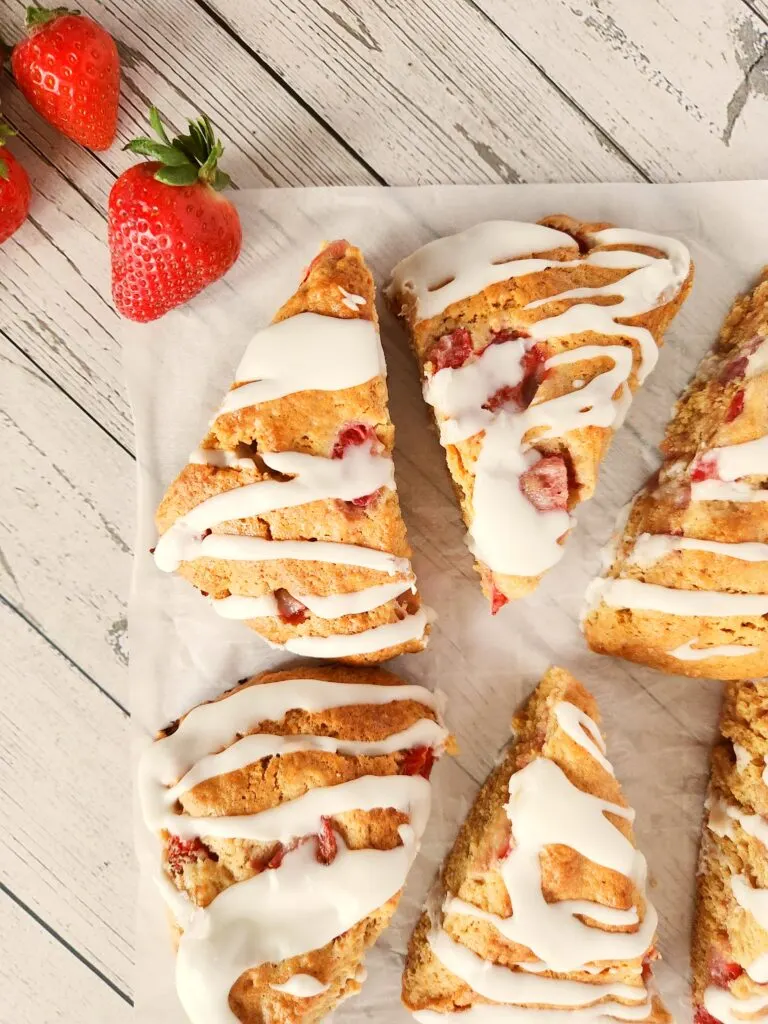
If you make your own scones, because they’re so versatile, you have the flexibility to create both sweet and savory variations with your favorite add-ins when you follow a basic scone recipe.
To make sweet scones, add 1 cup of dried fruit, chocolate chips or nuts. To make savory scones, mix in 1 cup of shredded cheese, mixed herbs or crumbled bacon.
How to Shape Scones
Shaping scones is a simple process that contributes to their texture and appearance.
Here’s a step-by-step guide on how to shape scones:
- Prepare your scone dough. The key is to handle the dough gently and avoid overmixing, which can result in tough scones.
- To prevent the dough from sticking, shape the dough on a lightly floured surface to prevent the dough from sticking.
- Turn the prepared scone dough out onto the floured surface. Use your hands to gently pat the dough into a circle or rectangle, depending on the type of scones you’re making.
- Aim for an even thickness of about 1 to 1.5 inches. If you prefer round scones, shape the dough into a circle. For triangular scones, shape it into a rectangle.
- Use a sharp knife or a scone cutter to cut the dough into individual scones. If you’re using a cutter, press straight down without twisting to keep the scones rising evenly.
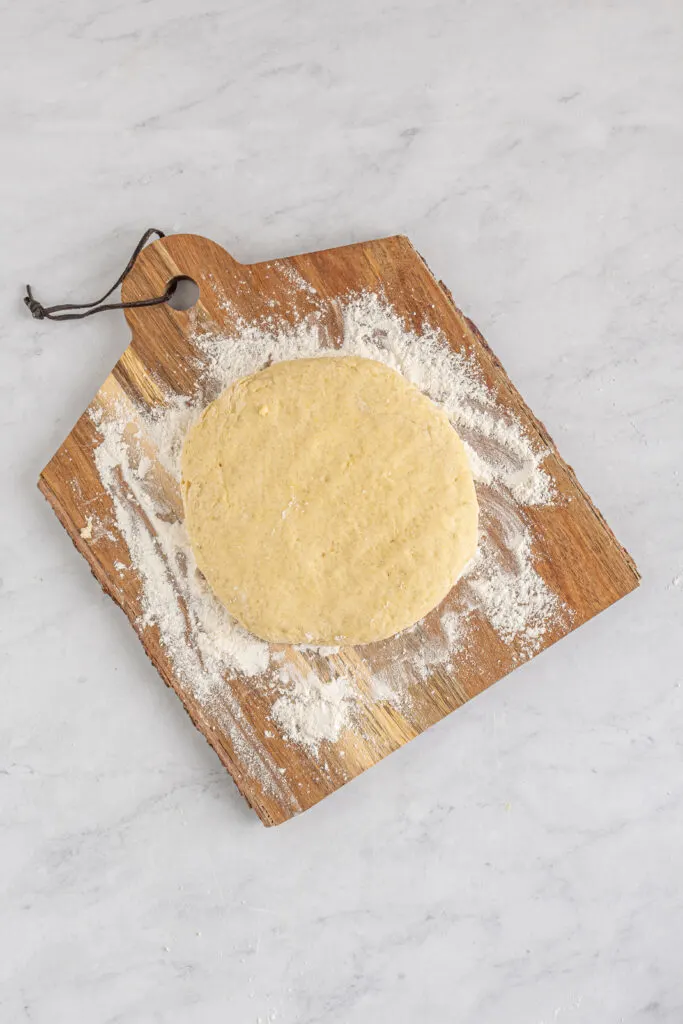
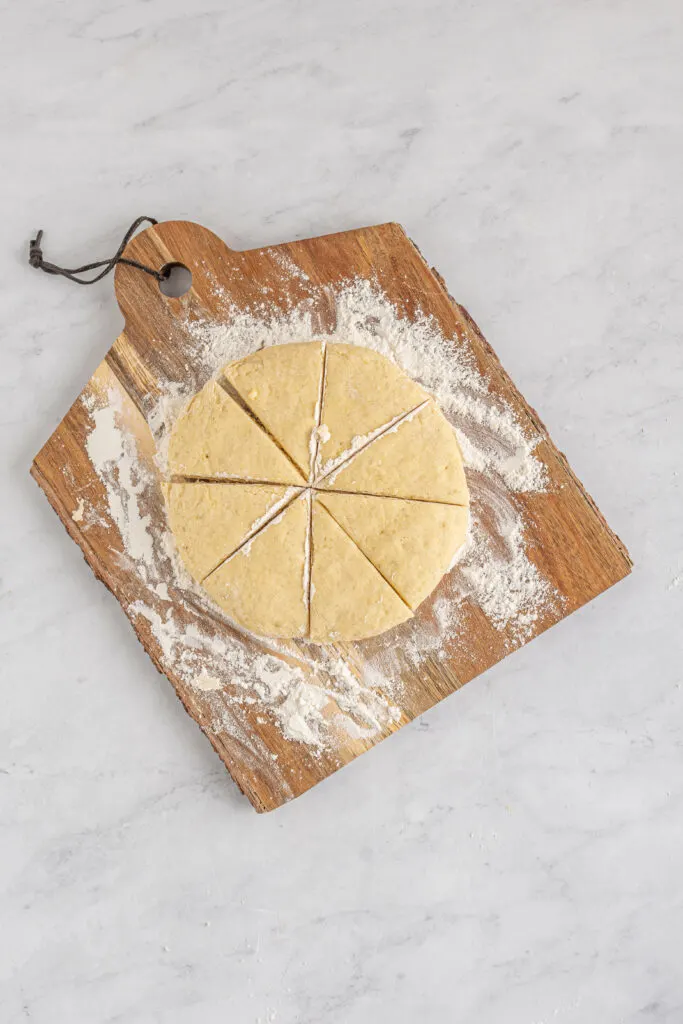
- After cutting out the initial scones, gather any remaining scraps of dough. Pat or roll them gently, and cut out additional scones. Try to handle the scraps as little as possible to maintain the scones’ texture.
- Transfer the shaped scones onto a parchment-lined baking sheet, leaving some space between each. This allows them room to expand while baking.
- If desired, you can brush the top of the scones with a bit of milk or beaten egg and turbinado sugar before baking. This gives them a golden color.


- For an extra flaky texture, you can chill the shaped scones in the refrigerator for about 15-30 minutes before baking.
- Preheat your oven and bake the shaped scones according to your recipe’s instructions. They are typically baked until golden brown and firm to the touch.

How to Make Scones Fluffy
Achieving fluffy, perfect scones involves a combination of ingredients and techniques.
- Ensure both your butter and any liquid ingredients (such as milk) are cold. Pieces of cold butter in the dough creates pockets of steam during baking, contributing to the scones’ flakiness and rise.
- Overmixing the dough can lead to dense scones. Mix the ingredients until just combined. This leaves small pieces of butter in the dough, as the butter melts during baking and create air pockets for a lighter texture.
- Use all-purpose flour, for a tender crumb and fluffy texture.
- Use fresh baking powder to ensure a good rise.
- After shaping the scones, consider chilling them in the refrigerator for about 15-30 minutes before baking. This helps solidify the fat (butter) in the dough, creating a flakier texture during baking.
- Instead of rolling out the dough with a rolling pin, gently pat it into a circle or rectangle. This method helps maintain the unevenness in the dough, promoting a better rise.
- When cutting out scones, use a sharp cutter and press straight down without twisting. Twisting can seal the edges and interfere with the scones’ ability to rise.
- Preheat your oven to the correct temperature before baking. A hot oven is essential for the initial rise of the scones.
- Place the shaped scones on a parchment-lined baking sheet with some space between them. This allows for proper air circulation and encourages an even rise.
- Keep a close eye on your scones while baking. Overbaking can result in a dry texture. Once they turn golden brown and feel firm to the touch, they’re ready.

How to Store Scones
If you plan to consume your scones within 1-2 days, you can store them at room temperature in an airtight container.
For longer storage, especially if your scones have perishable ingredients like cream or fruit, you can store them in the refrigerator. Place the scones in an airtight container or wrap them tightly with plastic wrap.
Before serving, allow them to come to room temperature or gently reheat in the oven at 300°F for a few minutes.
If stacking scones in a container, consider placing parchment paper or wax paper between layers to prevent them from sticking together.
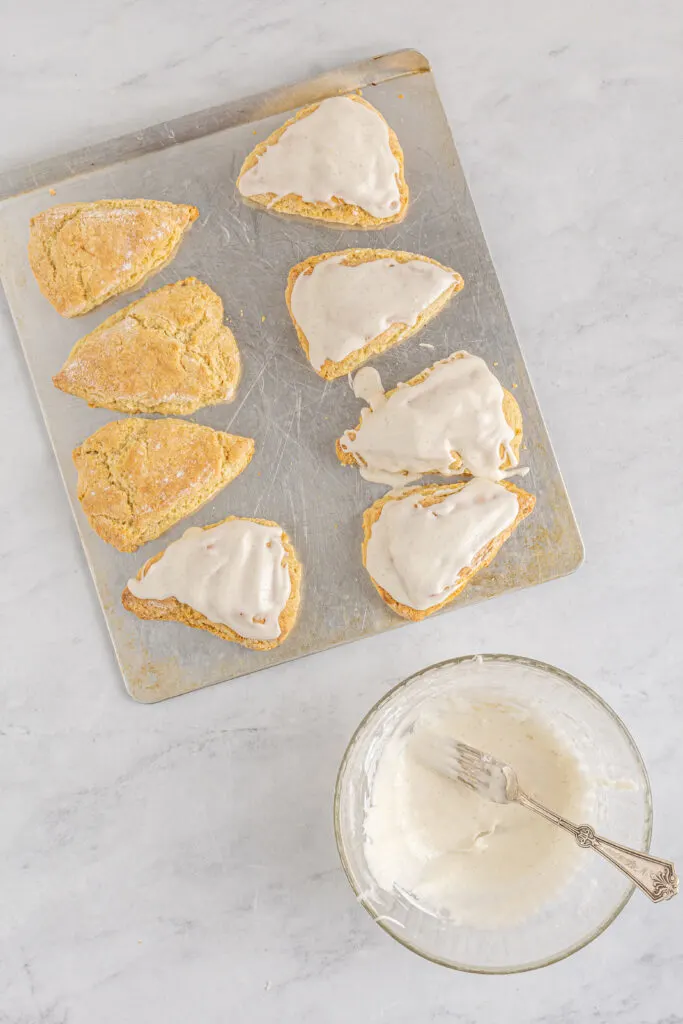
How to Reheat Scones
Reheating scones is a simple process to restore their warmth and freshness.
In a 350°F oven or toaster oven, heat for 5-10 minutes or until warmed through.
If you’re looking for a quick method, the microwave works well on a low to medium setting for 20-30 seconds. Wrap the scone in a damp paper towel to prevent it from drying out.

FAQs About Classic Scones
Can you make scones ahead of time?
Yes, you can make scone dough ahead of time and refrigerate or freeze it for later baking. Here’s how you can do it:
- Follow your scone recipe and prepare the dough up to the point just before baking.
- If you plan to shape the scones before storing, go ahead and cut them into individual portions.
- Place the shaped or unshaped scone dough in an airtight container or wrap it tightly with plastic wrap. Refrigerate the dough for up to 24 hours.
- If you want to make scones further in advance, consider freezing the shaped or unshaped dough. Wrap it well in plastic wrap and place it in a freezer-safe bag. Frozen scone dough can be stored for several weeks.
- If you froze the scone dough, transfer it to the refrigerator to thaw overnight before baking.
- When you’re ready to bake, preheat your oven, take the dough out of the refrigerator and proceed with baking. You may need to add a few minutes to the baking time if the dough is cold.
What is the difference between a scone vs biscuit?
Scones and biscuits share similarities in ingredients and preparation. However, key differences set them apart. A classic scone recipe is typically sweetened and known for a tender, crumbly texture. On the other hand, biscuits are more versatile, often unsweetened, and prized for their flaky and layered texture. They are commonly served as a savory side dish, complementing meals like breakfast or dinner. The choice between scones and biscuits depends on taste preferences and the occasion they’re intended for.
What is the difference between American scones and English Style Scones?
American scones and English scones differ in sweetness, texture, and serving traditions.
American scones are often sweeter, with variations like chocolate chips or fruit-flavored options, contributing to a crumbly and cake-like texture. They are commonly enjoyed on their own and can be treated as a dessert or breakfast pastry.
In contrast, English-style scones have a more moderate sweetness, a tender, biscuit-like texture, and are traditionally served during British afternoon tea. English-style scones are commonly paired with clotted cream and jam, embodying a classic and timeless aspect of British tea culture.
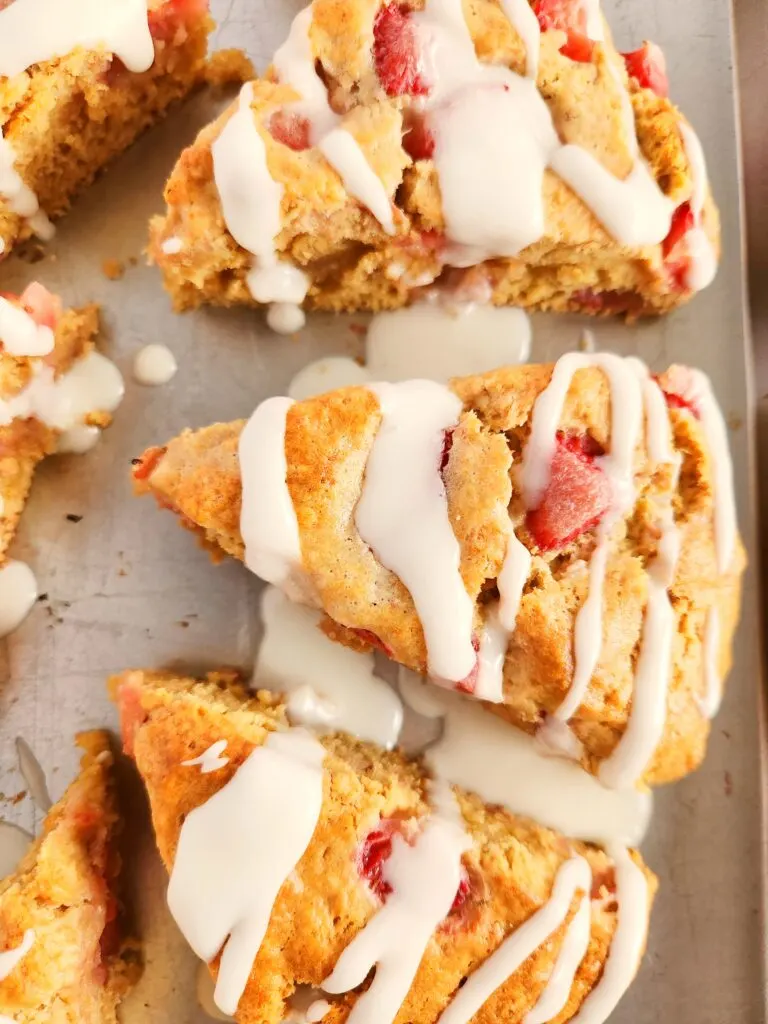
Contains affiliate links.
